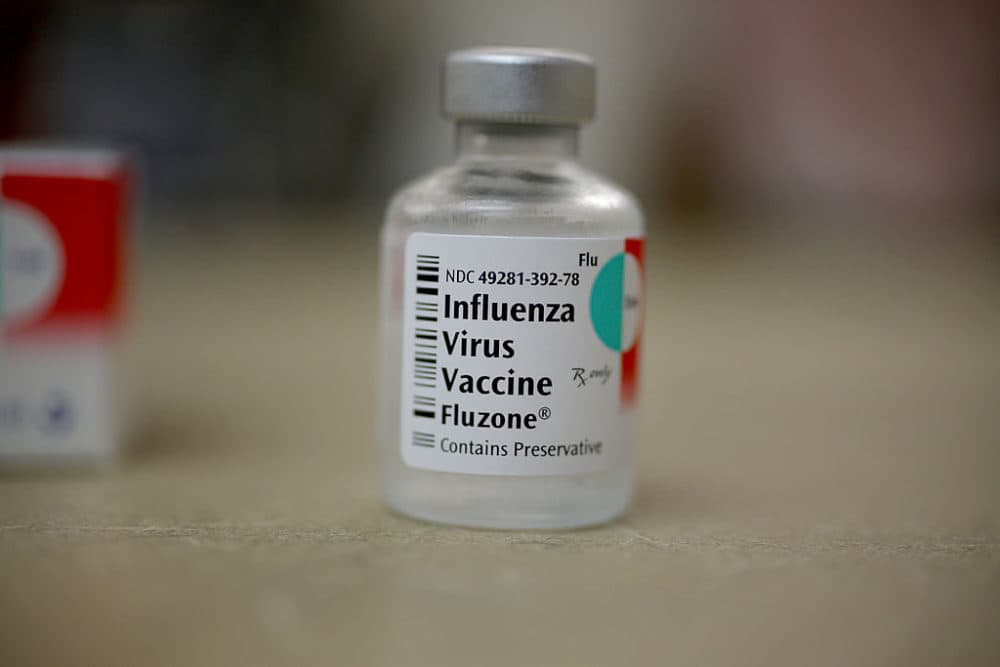Advertisement
Experts aren't sure what to expect this flu season. Here's why

Flu season has officially begun. While there are warnings about COVID and influenza causing a “twindemic” (maybe even a "tripledemic" with the respiratory virus R.S.V.), or the occasional dual infection some have dubbed "flurona,"experts say nobody knows exactly what is in store.
In Massachusetts, health officials have started publishing the weekly flu report. So far, they declare the severity “low.” Visits to doctors' offices for "flu-like illness" are higher now than at this point in the past three seasons, but they remain lower than what is typical for a non-flu season.
Across the country, most states have reported increases in flu activity, with the highest levels in southern states.
Despite the uncertainty about what lies ahead, here's a look at the best guesses for this flu season, why it’s so hard to predict the flu, and why some researchers are optimistic about new flu vaccines.
What health experts expect this flu season
Experts worry we're in for a worse-than-normal flu season. There are two main reasons for this concern.
First, the past several flu seasons have been particularly mild. Without the immunity that comes from recent infections, “more people may be more susceptible than usual to the flu this year,” explained Larry Madoff, medical director of the Bureau of Infectious Disease and Laboratory Sciences at the Massachusetts Department of Public Health.
Less immunity — and less mask-wearing — could be a recipe for a bad flu season.
Second, experts often look at the Southern Hemisphere, which is just wrapping up its flu season, as an indicator of what might happen in the Northern Hemisphere. In Australia in particular, things didn’t go well.
“They had a very bad flu season, a severe flu season with about three times their normal level of flu,” Madoff said. “So there's reason to think it could be a worse flu season than typical [here].”
Brian Chow, an infectious diseases physician at Tufts Medical Center, has also been looking at the data from Australia. However, he finds reason for cautious optimism. “They got hit early and hard, and cases have dropped substantially, which is encouraging for the Northern Hemisphere,” he said.
The one thing experts agree on: Nobody know what the flu season will look like until it happens.
“We really can't predict it very well. Every flu season is different, and especially now [with COVID],” said Madoff. “All I can say is that we are seeing a lot of unusual patterns in respiratory illness these days.”
Why flu is so hard to predict
There are a few reasons why the severity of flu season is challenging to forecast.
The influenza virus is constantly evolving. That makes it difficult to know which strains will be circulating from year to year. Some strains are slightly more transmissible; others are slightly less so. “Those small changes can make a large difference in a large population,” said Chow.
Dr. Jennifer Wang, a professor of infectious diseases at UMass Chan Medical School, said researchers think about how the virus is changing in terms of "drift" and "shift."
"Drift" is when there are small, subtle changes in the genome of the virus. She said this can make for a mismatch between the vaccine and the virus that's circulating, which means many vaccinated people will not be as good at fighting if off.
"Shift" is when big chunks of the virus's genome change. "And that's when there's mixing with animals," Wang said, pointing to two well-known examples: swine flu and avian flu. In both cases, the magnitude of the change meant few people had encountered a similar virus before. “Then our immune systems are very unprepared,” Wang said.
Another hard-to-predict factor in flu season is the weather. Changes in temperature and humidity impact how long the virus is able to survive outside the body.
“We know the cold, dry weather promotes transmission of influenza and also pushes people indoors into crowded spaces,” Madoff said.
Chow added that “global warming makes it even harder to predict” because weather patterns in both hemispheres are shifting and becoming more difficult to forecast.
Finally, a big new unknown is how flu interacts with COVID.
While each flu season may vary, the past two flu seasons have been particularly atypical. In 2020-21, there was almost no flu activity. In 2021-22, there was an early spike and a late spike, but a big drop in cases when flu usually peaks.
Experts attribute some of this to pandemic precautions: good hand hygiene, people wearing masks and many people staying home and avoiding crowds. But Wang thinks something else was likely happening, too.
She said there were a lot fewer co-infections — where a person has flu and COVID at the same time — than experts expected to see.
“In the beginning of the pandemic,” Wang said, “I remember thinking, ‘We're going to see a lot of dual infections.’ We didn't see that. In fact, COVID took over. And this happened again last winter.” As Omicron took off, infectious disease experts like Wang noticed flu infections plummeted.
While it is possible to get both viruses at the same time — and studies suggest it may lead to more severe illness — it seems to be rare. Wang’s guess is that “it probably had to do with how our bodies respond to COVID infection. And that may be providing a hostile environment for the flu.”
Other experts say it’s too early to be certain how the viruses interact, and that makes it even harder to predict what flu season will look like.
Hope for the future?
Wang is part of a team that’s working to create a new flu vaccine using mRNA, the building block for some of the COVID vaccines.
“This may be a game changer for how we treat flu in the future,” she said.
In standard flu vaccines, inactivated flu virus is injected into the body to trigger an immune response. The mRNA flu vaccine contains what are essentially cellular blueprints that spur the body to make flu proteins — or pieces of them — and then the immune system kicks into gear.
In most years, the standard flu vaccine is around 40% effective in preventing infection, and at its best, it’s been 60% effective, said Wang. She’s leading the Massachusetts site testing the new mRNA flu vaccine — which is produced by Pfizer — against the standard flu vaccine.
She's hopeful the mRNA flu vaccine will be more effective. And, she said, an mRNA vaccine is well-suited to a situation where there’s a mismatch between the vaccine and the strains of flu going around because it can be updated swiftly.
“These mRNA vaccines can be altered so quickly in the laboratory,” she said. “They can be adjusted as needed to match with what viruses are actually circulating in the population.”
Wang is hopeful that results from the national flu vaccine trial will be available before next year’s flu season. As for this year, experts recommend getting the standard flu vaccine by the end of October.
